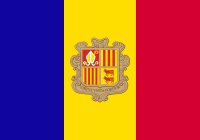 Andorra /ænˈdɒrə/ (help·info), officially the Principality of Andorra (Catalan: Principat d’Andorra), also called the Principality of the Valleys of Andorra, (Catalan: Principat de les Valls d’Andorra), is a small country in southwestern Europe, located in the eastern Pyrenees mountains and bordered by Spain and France. It is the sixth smallest nation in Europe having an area of 468 km2 (181 sq mi) and an estimated population of 83,888 in 2009. Its capital, Andorra la Vella, is one of the highest capital cities in Europe, being at an elevation of 1023 met. The official language is Catalan, although Spanish, French, and Portuguese are also commonly spoken.
Andorra /ænˈdɒrə/ (help·info), officially the Principality of Andorra (Catalan: Principat d’Andorra), also called the Principality of the Valleys of Andorra, (Catalan: Principat de les Valls d’Andorra), is a small country in southwestern Europe, located in the eastern Pyrenees mountains and bordered by Spain and France. It is the sixth smallest nation in Europe having an area of 468 km2 (181 sq mi) and an estimated population of 83,888 in 2009. Its capital, Andorra la Vella, is one of the highest capital cities in Europe, being at an elevation of 1023 met. The official language is Catalan, although Spanish, French, and Portuguese are also commonly spoken.
The Principality was formed in 1278. The role of monarch is exercised jointly by the two co-princes, the President of the French Republic and the Bishop of Urgell, Catalonia, Spain. This peculiarity makes the President of France, in his capacity as Prince of Andorra, the only reigning monarch actually elected in regular intervals by popular vote (Malaysian monarch is elected also, but not by popular vote).
Andorra is a prosperous country mainly because of its tourism industry, which services an estimated 10.2 million visitors annually, and also because of its status as a tax haven. It is not a member of the European Union, but the euro is the de facto currency. The people of Andorra have the 2nd highest human life expectancy in the world — 82 years at birth.
Andorran Culture is Catalan in essence, since the native-born population of Andorra is Catalan. However, it has given a significant and easily identifiable contribution to the conglomerate of Catalan culture.
Tourism, the mainstay of Andorra’s tiny, well-to-do economy, accounts for more than 80% of GDP. An estimated 11.6 million tourists visit annually, attracted by Andorra’s duty-free status and by its summer and winter resorts. Andorra’s comparative advantage has recently eroded as the economies of neighboring France and Spain have been opened up, providing broader availability of goods and lower tariffs. The banking sector, with its partial “tax haven” status, also contributes substantially to the economy.
Agricultural production is limited – only 2% of the land is arable – and most food has to be imported. The principal livestock activity is sheep raising. Manufacturing output consists mainly of cigarettes, cigars, and furniture. Andorra is a member of the EU Customs Union and is treated as an EU member for trade in manufactured goods (no tariffs) and as a non-EU member for agricultural products.
Notes from Wikipedia and Answers.com









